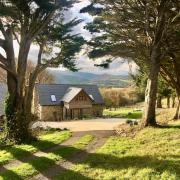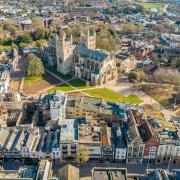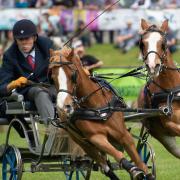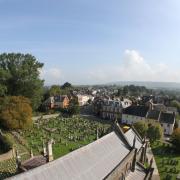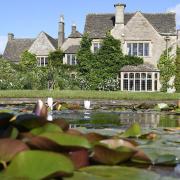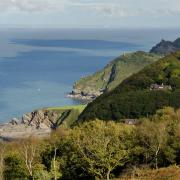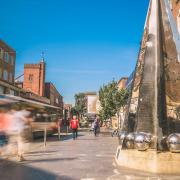Sue Cade takes a cautious expedition to discover some of the myths and legends that help to sustain Dartmoor’s reputation as an otherworldly place

With its miles of untamed countryside, wild rivers, stark tors, bogs, fogs and howling dogs, Dartmoor is home to more folklore than you can shake a stick at. This is no place to lose your way – you’re likely to come face to face with unspeakable apparitions, from the Hairy Hands to the Hound of the Baskervilles!
Okehampton to Tavistock
Tales of uncanny canines abound across Dartmoor. One enormous black hound is said to run ahead of a coach made of bones driven by a headless coachman, taking Lady Mary Howard from Fitzford House to Okehampton Castle, a now ruined castle set above the River Okement. Poor Mary was falsely reputed to have murdered four husbands, and her endless task is to remove all the grass from the castle mound, one blade at a time.
Drive into the heart of Dartmoor and the village of Postbridge – but beware those Hairy Hands. This legendary terror began in 1921 with the death of a worker from Dartmoor Prison who lost control of his motorcycle for no apparent reason. When another motorcyclist had the same experience, his passenger avowed a large hairy hand had taken the handlebars and forced the bike off the road. Similar incidents over the years confirm it is wise to take precautions when in the vicinity.
Doubling back to Princetown, the High Moorland Visitor Centre was once the Duchy Hotel, where Conan Doyle began writing The Hound of the Baskervilles, after hearing tales of evil Squire Cabell and the pack of fearsome black hounds he drove across the moor.
Tavistock to Ivybridge
A tale of revenge resides amidst the ruins of Tavistock Abbey where rebellious Benedictine monks drank, caroused and sold silver stolen from the altar when their Abbot was absent. Sobering up, they realised they would have to replace the silver, so they killed an old Jew for his money and buried him in a peat bog. Soon after, a messenger told the monks they had to travel across the moor to Buckfast. When they reached the scene of the crime, the messenger revealed himself as the skeleton ghost of the Jew and chased the monks to their deaths in the bog. The Abbot arranged for granite crosses to mark the path to keep future travellers safe, and they remain to this day on The Abbot’s Way, now a challenging 24-mile trail.
Unlucky travellers on their way south to Ivybridge might meet the Devil himself. He’s found in several guises on Dartmoor, but perhaps most famously as Old Dewer, reputed to ride the moor near Shaugh Prior at night with his devilish pack of Wisht Hounds causing terrified travellers to leap to their deaths from the Dewerstone. Today, adventurous climbers scale its highest cliff, the 150ft Devil’s Rock.
Ivybridge to Dunsford
A walk close to Burrator Reservoir passes through Deancombe Valley. The tale is told of the wealthy but disagreeable Weaver of Deancombe, who appeared in ghostly form at a loom the day after his funeral. The shrewd local parson turned his ghost into a black dog, found a nutshell and ordered the beast to use it to empty a pool along Dean Brook, which it is still attempting to do to this day.
Under Ashburton’s King’s Bridge, Kutty Dyer waits to pounce on misbehaving children and drink their blood. Not only that, but the evil water sprite also has a penchant for people who have drunk too much, so if you stop for lunch at the town’s Exeter Inn, be sure to stick to mineral water.
North now to Manaton, and a tale of witches. The huntsman, Bowerman, was out on the moor at Hayne Down when he and his dogs ran into a coven of witches and knocked over their cauldron. One witch turned herself into a hare and lured Bowerman into a mire before turning him into the distinctive tor that is called Bowerman’s Nose. His unfortunate dogs met the same fate and can be seen as a chain of rocks on nearby Hound Tor.
Dunsford to Okehampton
Heading back towards Okehampton, a rest-break at the Three Crown’s Hotel in Chagford unearths another Dartmoor literary legend. Mary Whiddon is alleged to be one of the inspirations behind R.D. Blackmore’s celebrated romantic character, Lorna Doone. Mary was loved by two men and agreed to marry one of them. Tragically, as she and her new husband left the church, the jilted suitor shot her dead. Her ghost is reputed to walk a secret passage from her home, Whiddon Park House, to the pub, where she appears in The Bishop’s Room and upstairs corridors.
We end at a circle of stones near Belstone Tor, known variously as the Nine Maidens or the Seventeen Brothers.
The site is in fact a Bronze Age burial chamber, but local lore relates that the stones were once people who were petrified because they dared to dance on the Sabbath. The stones are said to sway slightly every day at midday, as if dancing.
Four ways to encounter the legends of Dartmoor
On foot: Walk with an experienced local guide: moorlandguides.co.uk includes walks that explore myths and legends.
By bike: The Dartmoor Way has been updated to a 95 mile circular route round the moor, and themed tours are currently being devised: dartmoorway.co.uk. If you don’t own a bike, hire one locally.
On horseback: Ten stables listed on dartmoor.co.uk offer hacks on the moor, including one that rides out exclusively with Clydesdale Heavy Horses – these will give the Whisht Hounds a run for their money!
By safari: dartmoorsafaris.co.uk has a ‘Taste of Dartmoor Safari’ taking in locations such as Brent Tor, Hound Tor, Princetown and scenes from the Hound of the Baskervilles.
This article was first published in the March issue of Devon Life. To get the magazine delivered every month to your home, subscribe at www.subscriptionsave.co.uk/dev or call 08448484217



